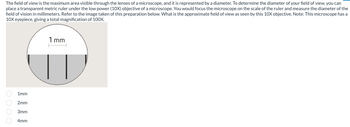
Human Anatomy & Physiology (11th Edition)
11th Edition
ISBN: 9780134580999
Author: Elaine N. Marieb, Katja N. Hoehn
Publisher: PEARSON
expand_more
expand_more
format_list_bulleted
Concept explainers
Question

Transcribed Image Text:The field of view is the maximum area visible through the lenses of a microscope, and it is represented by a diameter. To determine the diameter of your field of view, you can
place a transparent metric ruler under the low power (10X) objective of a microscope. You would focus the microscope on the scale of the ruler and measure the diameter of the
field of vision in millimeters. Refer to the image taken of this preparation below. What is the approximate field of view as seen by this 10X objective. Note: This microscope has a
10X eyepiece, giving a total magnification of 100X.
0000
1mm
2mm
3mm
4mm
1mm
Expert Solution
This question has been solved!
Explore an expertly crafted, step-by-step solution for a thorough understanding of key concepts.
This is a popular solution
Trending nowThis is a popular solution!
Step by stepSolved in 3 steps with 1 images

Knowledge Booster
Learn more about
Need a deep-dive on the concept behind this application? Look no further. Learn more about this topic, biology and related others by exploring similar questions and additional content below.Similar questions
- In light microscopy, when magnification is increased, the lens focuses closer to the sample. This makes the user more likely to ram the sample into the lens. Why is it common for the lens to focus closer to the sample at higher magnifications? What can be done to mitigate this risk?arrow_forwardThe diffraction limit is an unbeatable barrier limiting the effective resolution of light microscopy due to the inherent wavelength of light.True or Falsearrow_forwardWhat is the final magnification that you would obtain if you were viewing an object through a microscope with a 40X objective lens and a 25.5X ocular lens?arrow_forward
- Describe the conditions under which dark-field microscopy is the best choice for viewing specimens.arrow_forwardPlease answer the question along with the reason I'll definitely give a likearrow_forwardYou have placed a microscope slide in a microscope and want to view it at with the 10X objective lens. List the steps that are necessary to set up and focus the microscope properly using the 10X objective lens.arrow_forward
- What is phase contrast? Give examples of phase contrast in optical microscopy.arrow_forwardWhat is the diameter of the field of view (ie. Diameter2) when the total magnification is 100X? Report your answer in µmarrow_forwardWhat is the proper method of cleaning the microscope? Select an answer. a. Change the magnification to the lowest power, clean the objective lens and ocular lens with lens paper b. Change the magnification to the highest power, clean the objective lens and ocular lens with lens paper c. Change the magnification to the lowest power, clean the objective lens and ocular lens with a paper towelarrow_forward
- The compound (bright-field) microscope is parfocal. It means that: Question 4 options: objective lenses are built into revolving nosepiece its lenses effectively decrease focal lenght can achieve maximum resolution lower than 0.2 μm image should remain in focus when objective lens is changedarrow_forwardDescribe how you would use a compound light microscope with the 4 objective lenses to view a specimen on a pre-made slide up to a total magnification of 400X.arrow_forwardWhat causes these reversals in orientation and movement of objects seen through the microscope?arrow_forward
arrow_back_ios
SEE MORE QUESTIONS
arrow_forward_ios
Recommended textbooks for you
 Human Anatomy & Physiology (11th Edition)BiologyISBN:9780134580999Author:Elaine N. Marieb, Katja N. HoehnPublisher:PEARSON
Human Anatomy & Physiology (11th Edition)BiologyISBN:9780134580999Author:Elaine N. Marieb, Katja N. HoehnPublisher:PEARSON Biology 2eBiologyISBN:9781947172517Author:Matthew Douglas, Jung Choi, Mary Ann ClarkPublisher:OpenStax
Biology 2eBiologyISBN:9781947172517Author:Matthew Douglas, Jung Choi, Mary Ann ClarkPublisher:OpenStax Anatomy & PhysiologyBiologyISBN:9781259398629Author:McKinley, Michael P., O'loughlin, Valerie Dean, Bidle, Theresa StouterPublisher:Mcgraw Hill Education,
Anatomy & PhysiologyBiologyISBN:9781259398629Author:McKinley, Michael P., O'loughlin, Valerie Dean, Bidle, Theresa StouterPublisher:Mcgraw Hill Education, Molecular Biology of the Cell (Sixth Edition)BiologyISBN:9780815344322Author:Bruce Alberts, Alexander D. Johnson, Julian Lewis, David Morgan, Martin Raff, Keith Roberts, Peter WalterPublisher:W. W. Norton & Company
Molecular Biology of the Cell (Sixth Edition)BiologyISBN:9780815344322Author:Bruce Alberts, Alexander D. Johnson, Julian Lewis, David Morgan, Martin Raff, Keith Roberts, Peter WalterPublisher:W. W. Norton & Company Laboratory Manual For Human Anatomy & PhysiologyBiologyISBN:9781260159363Author:Martin, Terry R., Prentice-craver, CynthiaPublisher:McGraw-Hill Publishing Co.
Laboratory Manual For Human Anatomy & PhysiologyBiologyISBN:9781260159363Author:Martin, Terry R., Prentice-craver, CynthiaPublisher:McGraw-Hill Publishing Co. Inquiry Into Life (16th Edition)BiologyISBN:9781260231700Author:Sylvia S. Mader, Michael WindelspechtPublisher:McGraw Hill Education
Inquiry Into Life (16th Edition)BiologyISBN:9781260231700Author:Sylvia S. Mader, Michael WindelspechtPublisher:McGraw Hill Education

Human Anatomy & Physiology (11th Edition)
Biology
ISBN:9780134580999
Author:Elaine N. Marieb, Katja N. Hoehn
Publisher:PEARSON

Biology 2e
Biology
ISBN:9781947172517
Author:Matthew Douglas, Jung Choi, Mary Ann Clark
Publisher:OpenStax

Anatomy & Physiology
Biology
ISBN:9781259398629
Author:McKinley, Michael P., O'loughlin, Valerie Dean, Bidle, Theresa Stouter
Publisher:Mcgraw Hill Education,

Molecular Biology of the Cell (Sixth Edition)
Biology
ISBN:9780815344322
Author:Bruce Alberts, Alexander D. Johnson, Julian Lewis, David Morgan, Martin Raff, Keith Roberts, Peter Walter
Publisher:W. W. Norton & Company

Laboratory Manual For Human Anatomy & Physiology
Biology
ISBN:9781260159363
Author:Martin, Terry R., Prentice-craver, Cynthia
Publisher:McGraw-Hill Publishing Co.

Inquiry Into Life (16th Edition)
Biology
ISBN:9781260231700
Author:Sylvia S. Mader, Michael Windelspecht
Publisher:McGraw Hill Education